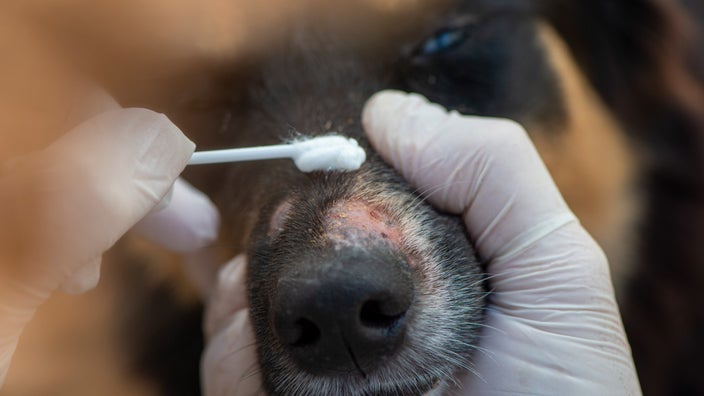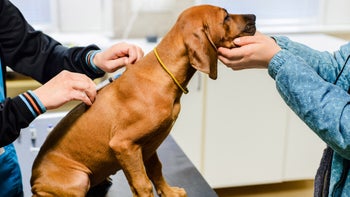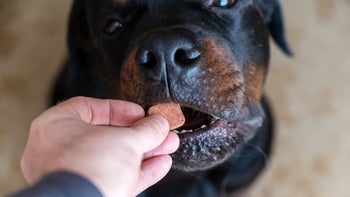
Ringworm in Dogs: Everything You Need to Know, From a Veterinarian
Key takeaways:
Ringworm is not a worm but a fungal infection that causes circular-shaped hair loss with a crusty covering.
Dogs can get ringworm from direct contact with affected animals, the environment, or contaminated household items.
If your dog gets ringworm, the fungus is easily treated with medications your vet can prescribe.
Access savings on related medications
Table of contents

While the name suggests a parasite, ringworm isn’t a worm at all. It’s a fungus that causes ring-shaped bald patches on your dog’s skin. It can also affect their hair and nails. Although a ringworm infection is not life-threatening, it can be uncomfortable for your dog and cause fur loss. It can also infect you.
Learn everything you need to know about ringworm infections in dogs and how to treat them.
What is ringworm in dogs?
Ringworm — also known as dermatophytosis — is a fungal infection that affects your dog’s skin. The tiny spores (or seeds) of the fungus reproduce in the dead outer layers of the skin and spread to other parts of your dog. One of the first things you’ll notice is circular patches of fur loss. This is because the fungus makes your dog’s fur fragile and vulnerable to breaking.
Jay Rowan, VMD, chief veterinarian and practice owner of Paoli Vetcare in Pennsylvania, said that ringworm isn’t actually a parasite. But it can be confusing because the infection often looks like it was caused by worms.
Fungal symptoms: Don’t let a fungal infection like ringworm catch you off guard. Here are common signs of these infections in dogs.
Why they’re itching: Dogs can itch for many reasons, from seasonal allergies to a skin infection.
Treat hotspots at home: Itchy dogs can sometimes create a hotspot — a red, irritated patch of skin. Here’s what you can do to manage these at home.
How do dogs get ringworm?
Dogs can catch ringworm either through direct contact with an affected animal or from the environment, typically while digging in dirt or rolling around. Your pooch may also get infected if they come in contact with contaminated items such as:
Couches
Rugs
Hair brushes
Food bowls
Bedding
Without proper cleaning, ringworm spores can stay on some surfaces, like combs or bowls, for months.
Save on the top 10 pet medications
Save big on common pet medications like Fluoxetine and Levetiracetam at your local pharmacy.

GoodRx is NOT insurance. GoodRx Health information and resources are reviewed by our editorial staff with medical and healthcare policy and pricing experience. See our editorial policy for more detail. We also provide access to services offered by GoodRx and our partners when we think these services might be useful to our visitors. We may receive compensation when a user decides to leverage these services, but making them available does not influence the medical content our editorial staff provides.
Ringworm infections are more common in puppies because they have an underdeveloped immune system. But they can impact all dogs. Canines that live in close quarters with other animals in shelters or kennels are also more prone to catching ringworm.
What does ringworm look like on a dog?
According to Rowan, ringworm symptoms in dogs can include hair loss — sometimes in ring-shaped patches — and crusty skin.
“Affected areas can involve any portion of the skin, but [the] feet, face, and ears seem to have a predilection for the condition,” said Rowan.
Signs and symptoms of ringworm
Other ringworm symptoms to look out for include:
Grey and scaly patches
Red areas on your dog’s skin
Raised, skinless patches that may ooze
Ringworm infections can also lead to inflammation of the nails, and your dog’s claws can become brittle and break easily. The infection may or may not cause itching.
Read more like this
Explore these related articles, suggested for readers like you.
How to treat ringworm in dogs
Treating ringworm in dogs takes time and patience. If you notice ringworm symptoms, even minor ones, take your pet to the veterinarian.
Your vet will use special lighting to look at your dog’s skin for signs of ringworm. Your vet may also take a sample of the infected area, inspect your dog’s hair under a microscope, or perform a skin biopsy before suggesting treatment.
Medications for treating ringworm in dogs
Oral antifungal medications in pill or tablet form are a good ringworm treatment for dogs, according to Rowan. He recommends terbinafine along with topical creams you apply directly on your dog’s skin, such as miconazole and clotrimazole.
“When topical medication is used, it should be applied for 2 to 4 weeks,” Rowan said. Severe ringworm cases may need a minimum treatment protocol of 6 weeks. But Rowan usually recommends oral and topical medications together, as topical treatment alone is usually not enough.
Only use topical medication on the specific spots with the ringworm infection. Afterward, put an Elizabethan collar — also known as an e-collar or cone — on your pooch to prevent them from licking the area and swallowing medication.
For minor infections, or to stop ringworm from getting worse, your vet may recommend an over-the-counter antifungal shampoo used at least twice a week.
What happens if ringworm goes untreated in dogs?
Ringworm can go away on its own. But it will take longer than treating the infection. Your dog will also be uncomfortable and contagious for a longer period of time without treatment.
Untreated ringworm in dogs can spread to all of their skin. However, Rowan said this is rare. Ringworm can also come back if it’s not treated properly the first time around.
In addition, ringworm is very contagious. The longer your dog goes without treatment, the more likely it is that ringworm will spread to other animals and even to you.
Can you catch ringworm from your dog?
Yes. Ringworm is a zoonotic infection, which means it can spread from animals to humans. Anyone who comes into contact with infected dogs or cats can catch it. Cats seem to be more prone to ringworm than dogs. But that doesn’t mean you can let your guard down around an affected canine.
Just like puppies are more prone to catching ringworm, children are more susceptible as well. So be sure to keep kids away from dogs with this condition. Talk to your healthcare professional if you suspect that you or your child may have contracted ringworm. Symptoms in humans include skin patches that are red, raised, and itchy.
How do you prevent ringworm from spreading?
Rowan recommends proper hygiene if your dog is infected with ringworm. That means washing your hands often. Also avoid snuggling with dogs you know have ringworm to prevent transmission. Keep infected dogs quarantined from other humans and animals in your home until the condition is cured.
Since ringworm is so infectious, it’s best to keep your house clean of any shed fur, dead skin, or ringworm spores. Regular vacuuming, washing your dog’s bedding, and cleaning anything else they touch can prove helpful. And of course, proper treatment is key to preventing ringworm from spreading.
The bottom line
Ringworm — a fungal infection that affects your dog’s skin — is a common but treatable health issue. If you notice bald patches, itchiness, or crusty skin, take your dog to the vet. They may recommend treatments such as prescription antifungal oral and topical medications.
While ringworm is infectious, with prompt action you can prevent the condition from getting worse and from spreading to other animals and humans.
Why trust our experts?



References
Brooks, W. (2023). Ringworm in dogs and cats. Veterinary Partner.
Merchant, S. R. (2018). Ringworm (dermatophytosis) in dogs. Merck Veterinary Manual.
Moriello, K. A., et al. (2017). Diagnosis and treatment of dermatophytosis in dogs and cats. Veterinary Dermatology.





























